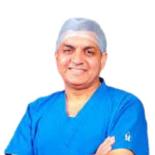About Neurointerventional Radiology
Best Interventional Radiology Hospital in India: Interventional Radiology Treatment Hospital | Fortis Healthcare
Interventional Radiology (IR) is a medical specialty that uses advanced imaging techniques such as X-rays, MRI, or ultrasound to guide minimally invasive procedures for diagnosing and treating various diseases throughout the body. Unlike traditional open surgery, IR procedures are performed through small incisions or natural openings, resulting in less pain, bleeding, infection, and scarring. IR procedures are usually done on an outpatient basis, allowing patients to return home the same day and recover faster. IR is also more cost-effective and has lower risk of complications than other treatment options. IR can treat a wide range of conditions, from vascular diseases such as aneurysms, blockages, and cancer, such as liver, kidney, lung, and bone tumours. IR offers patients a less invasive yet highly effective alternative for diagnosis and treatment.
Best Interventional Radiology Hospital in India
Interventional radiology is a rapidly evolving and expanding field that requires advanced technology, equipment, and expertise. Fortis Healthcare is one of the best interventional radiology hospitals in India and is specialised in all types of interventional radiology treatments. Fortis Healthcare has a team of highly qualified and experienced interventional radiologists who are trained in the latest techniques and protocols. We have state-of-the-art infrastructure and facilities that ensure the highest standards of safety, quality, and patient care.
Fortis Healthcare offers a wide range of interventional radiology services for various conditions such as:
- Cancer: Fortis Healthcare provides comprehensive and personalised care for patients with cancer, using interventional radiology to diagnose, stage, treat, and palliate various types of tumours. Some of the interventional radiology procedures for cancer include:
- Transarterial chemoembolization (TACE): To deliver chemotherapy directly to the tumour and block its blood supply.
- Radioembolization: To deliver radioactive microspheres to the tumour and destroy it with radiation.
- Percutaneous ethanol injection (PEI): To inject alcohol into the tumour and cause necrosis.
- Microwave ablation: To heat and kill the tumour cells with microwave energy.
- Cryoablation: To freeze and destroy the tumour cells with liquid nitrogen.
- Irreversible electroporation (IRE): To create pores in the tumour cell membrane and cause cell death.
- Vascular diseases: Fortis Healthcare offers interventional radiology solutions for various vascular diseases that affect the arteries, veins, or lymphatic system. Some of the interventional radiology procedures for vascular diseases include:
- Angioplasty and stenting: To open up narrowed or blocked arteries or veins and improve blood flow.
- Atherectomy: To remove plaque or calcification from the artery wall and restore blood flow.
- Endovascular aneurysm repair (EVAR): To place a stent graft inside the aneurysm and prevent it from rupturing.
- Venous access: To insert a catheter or port into a vein for long-term medication, dialysis, or blood transfusion.
- Varicose vein treatment: To close or remove varicose veins using laser, radiofrequency, or sclerotherapy.
- Women’s health: Fortis Healthcare provides interventional radiology services for various women’s health issues such as:
- Uterine fibroid embolization (UFE): To block the blood supply to the fibroids and shrink them.
- Ovarian vein embolization: To treat pelvic congestion syndrome caused by varicose veins in the pelvis.
- Fallopian tube recanalization: To clear the blockage in the fallopian tubes and restore fertility.
- Endometrial ablation: To destroy the lining of the uterus and reduce heavy menstrual bleeding.
- Men’s health: Fortis Healthcare provides interventional radiology services for various men’s health issues such as:
- Prostate artery embolization (PAE): To reduce the size of the enlarged prostate and relieve urinary symptoms.
- Varicocele embolization: To treat varicocele, a condition where the veins in the scrotum become enlarged and cause pain, infertility, or low testosterone.
- Testicular vein embolization: To treat testicular torsion, a condition where the testicle twists and cuts off its blood supply.
- Pain management: Fortis Healthcare provides interventional radiology services for various pain conditions such as:
- Spinal interventions: To treat back pain, neck pain, or sciatica caused by herniated discs, spinal stenosis, or nerve compression. Some of the spinal interventions include:
- Epidural steroid injection: To inject steroids into the epidural space and reduce inflammation and pain.
- Facet joint injection: To inject steroids or local anaesthetic into the facet joints and relieve pain.
- Nerve root block: To inject steroids or local anaesthetic near the nerve root and block pain signals.
- Radiofrequency ablation: To destroy the nerve fibers that carry pain signals using radiofrequency waves.
- Joint injections: To treat pain in the joints such as the shoulder, hip, knee, or ankle. Some of the joint injections include:
- Steroid injection: To inject steroids into the joint and reduce inflammation and pain.
- Hyaluronic acid injection: To inject hyaluronic acid into the joint and lubricate and cushion it.
- Platelet-rich plasma (PRP) injection: To inject PRP, a concentrated solution of platelets and growth factors, into the joint and stimulate healing and regeneration.
- Sympathetic blocks: To treat pain caused by complex regional pain syndrome (CRPS), a condition where the nervous system becomes overactive and causes severe pain, swelling, and changes in the skin. Some of the sympathetic blocks include:
- Stellate ganglion block: To inject local anaesthetic into the stellate ganglion, a group of nerves in the neck that control the sympathetic activity in the upper extremities.
- Lumbar sympathetic block: To inject local anaesthetic into the lumbar sympathetic chain, a group of nerves in the lower back that control the sympathetic activity in the lower extremities.
- Celiac plexus block: To inject local anaesthetic into the celiac plexus, a group of nerves in the abdomen that control the sympathetic activity in the abdominal organs.
- Spinal interventions: To treat back pain, neck pain, or sciatica caused by herniated discs, spinal stenosis, or nerve compression. Some of the spinal interventions include:
Get to Know our Team of Experts for Interventional Radiology
Fortis Healthcare has a team of highly qualified and experienced interventional radiologists who are trained in the latest techniques and protocols. They are supported by a multidisciplinary team of specialists from various fields such as oncology, cardiology, neurology, nephrology, gastroenterology, urology, gynaecology, and orthopaedics, we promise comprehensive care tailored to your specific needs.
Cost Of Treatment
The cost of treatment for interventional radiology treatments at Fortis depends on various factors, such as the type of treatment and extent of surgery, the need for additional therapies, the duration of hospital stays, and the insurance coverage. At Fortis, we are committed to providing quality care at reasonable and transparent prices. Our patients can benefit from our flexible payment options and financial assistance. We also collaborate with different insurance companies and claim handlers to simplify the reimbursement process for you. To know the approximate cost of treatment, get in touch with us or schedule an online consultation with the experts for further information.
Why Fortis Healthcare is the best hospital for interventional radiology
- Expert Team: Our hospital has a team of highly qualified and experienced interventional radiologists who are leaders in their field. They are well-versed in the latest techniques and protocols, ensuring that you receive the most advanced and effective treatments available.
- State-of-the-Art Infrastructure: Our cutting-edge technology and facilities enable precise and minimally invasive procedures, leading to better outcomes and faster recovery. We also have a dedicated interventional radiology suite, equipped with advanced imaging and monitoring systems, that allows us to perform complex and high-risk procedures with ease and accuracy.
- Comprehensive Services: We offer a wide range of interventional radiology procedures, catering to various conditions, such as cancer, vascular diseases, women’s health, men’s health, and pain management. Our comprehensive approach ensures that you receive customised treatment plans that address your specific needs and goals.
- Patient-Centric Culture: At Fortis Healthcare, we have cultivated a patient-centric culture, focused on delivering the best outcomes and enhancing the quality of life for our patients. We also provide you with education and counselling, helping you to make informed decisions and cope with your condition.
- Reputation for Excellence: With a reputation for excellence and innovation in the field of interventional radiology, Fortis Healthcare is recognized by various national and international accreditations and awards. Our commitment to quality and patient care has earned us the trust and confidence of patients and healthcare professionals alike.
Our Team of Experts
View allRelated Specialities
Other Specialities
-
Explore Hospitals for
Fortis Cancer Institute, Defence Colony, New Delhi Fortis Memorial Research Institute, Gurgaon Fortis CDOC, Chirag Enclave, New Delhi Fortis Escorts Heart Institute, New Delhi Fortis Flt. Lt. Rajan Dhall Hospital, Vasant Kunj, New Delhi Fortis La Femme, Greater Kailash II, New Delhi Fortis Escorts Hospital, Faridabad Fortis Hospital, Noida Fortis Hospital, Shalimar Bagh, New Delhi Fortis Escorts Hospital, Amritsar Fortis Hospital, Mohali Fortis Escorts Hospital, Jaipur Fortis Hospital, Anandpur, Kolkata Fortis Hospital CG Road Bangalore Fortis Hospital - Greater Noida Fortis Hospital & Kidney Institute, Gariahat, Kolkata Fortis Hospital BG Road Bangalore Fortis Nagarbhavi Bangalore Fortis Hospital, Rajajinagar, Bengaluru Fortis Hospital, Richmond Road, Bengaluru Hiranandani Fortis Hospital, Vashi, Mumbai Fortis Hospital, Mulund, Mumbai Fortis Hospital, Kalyan, Mumbai Fortis Hospital, Ludhiana S L Raheja Hospital, Mumbai Fortis Hospital Mall Road, Ludhiana -
Explore Doctors for by Hospital
Doctors in Fortis Cancer Institute, Defence Colony, New Delhi Doctors in Fortis Memorial Research Institute, Gurgaon Doctors in Fortis CDOC, Chirag Enclave, New Delhi Doctors in Fortis Escorts Heart Institute, New Delhi Doctors in Fortis Flt. Lt. Rajan Dhall Hospital, Vasant Kunj, New Delhi Doctors in Fortis La Femme, Greater Kailash II, New Delhi Doctors in Fortis Escorts Hospital, Faridabad Doctors in Fortis Hospital, Noida Doctors in Fortis Hospital, Shalimar Bagh, New Delhi Doctors in Fortis Escorts Hospital, Amritsar Doctors in Fortis Hospital, Mohali Doctors in Fortis Escorts Hospital, Jaipur Doctors in Fortis Hospital, Anandpur, Kolkata Doctors in Fortis Hospital CG Road Bangalore Doctors in Fortis Hospital - Greater Noida Doctors in Fortis Hospital & Kidney Institute, Gariahat, Kolkata Doctors in Fortis Hospital BG Road Bangalore Doctors in Fortis Nagarbhavi Bangalore Doctors in Fortis Hospital, Rajajinagar, Bengaluru Doctors in Fortis Hospital, Richmond Road, Bengaluru Doctors in Hiranandani Fortis Hospital, Vashi, Mumbai Doctors in Fortis Hospital, Mulund, Mumbai Doctors in Fortis Hospital, Kalyan, Mumbai Doctors in Fortis Hospital, Ludhiana Doctors in S L Raheja Hospital, Mumbai Doctors in Fortis Hospital Mall Road, Ludhiana














